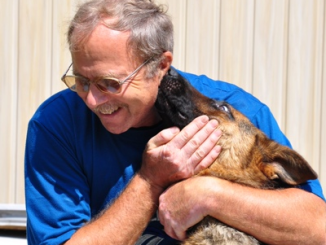Dogs’ brains are sensitive to the familiar high-pitched “cute” voice tone that adult humans, especially women, use to talk to babies, according to a new study.
The research, published recently in the journal Communications Biology, found “exciting similarities” between infant and dog brains during the processing of speech with such a high-pitched tone feature.
Humans tend to speak with a specific speech style characterised by exaggerated prosody, or patterns of stress and intonation in a language, when communicating with individuals having limited language competence.
Such speech has previously been found to be very important for the healthy cognitive, social and language development of children, who are also tuned to such a high-pitched voice.
But researchers, including those from the Eötvös Loránd University in Hungary, hoped to assess whether dog brains are also sensitive to this way of communication.
In the study, conscious family dogs were made to listen to dog, infant and adult-directed speech recorded from 12 women and men in real-life interactions.
As the dogs listened, their brain activities were measured using a functional magnetic resonance imaging (fMRI) scan.
The study found the sound-processing regions of the dogs’ brains responded more to dog- and infant-directed than adult-directed speech.
This marked the first neurological evidence that dog brains are tuned to speech directed specifically at them.
“Studying how dog brains process dog-directed speech is exciting, because it can help us understand how exaggerated prosody contributes to efficient speech processing in a nonhuman species skilled at relying on different speech cues,” explained Anna Gergely, co-first author of the study.
Scientists also found dog- and infant-directed speech sensitivity of dog brains was more pronounced when the speakers were women, and was affected by voice pitch and its variation.
These findings suggest the way we speak to dogs matters, and that their brain is specifically sensitive to the higher-pitched voice tone typical to the female voice.
“Remarkably, the voice tone patterns characterizing women’s dog-directed speech are not typically used in dog-dog communication – our results may thus serve evidence for a neural preference that dogs developed during their domestication,” said Anna Gábor, co-first author of the study.
“Dog brains’ increased sensitivity to dog-directed speech spoken by women specifically may be due to the fact that women more often speak to dogs with exaggerated prosody than men,” Dr Gabor said.

Doggie Dad Decided To Sell His House To Keep His Precious Babygirl Alive

Everyone who has ever had a veterinary emergency with their beloved, four-legged best friend knows both how pricey and how gut-wrenching the entire experience is.
So when one doggie dad faced veterinary expenditures reaching just shy of $24,000, he said he was willing to go to unusual measures to keep his baby girl alive.

Jaxon is the dad of a two-year-old Weimaraner named Rambo. For reasons that are still unknown, Rambo fell into hypovolemic shock, which means her heart was unable to pump blood to the rest of her body. Not only that, but she also suffered gastroenteritis, or a stomach flu.
“She began vomiting throughout the night over 30 times and by Saturday am we were in the emergency vets,” said Rambo’s dad.

As you may have guessed, this caused her health to worsen rapidly, and they weren’t sure how long she’d have to be in emergency care. On top of hypovolemic shock and gastrointestinal issues, fluids started leaking into her lungs, and she got pneumonia. One of her lungs even collapsed.
Being at the emergency vet under 24/7 surveillance is ultimately what saved her life but it cost over £1000 ($1200 USD) per day to be under their care. Rambo’s insurance would cover her up to £6500 ($7,800), but her cost was already at £11,500 ($13,800) after only a single week in their care.

So Jaxon launched a gofundme page to try to get funds for Rambo’s crucial care. He even indicated that he was willing to ‘sell his house.’
“If the worst happens and Rambo requires significant surgery, the cost of this as well as the aftercare is something I need to be able to provide my beautiful baby girl,” added Jaxon.

Her dad got so frightened that he started sleeping in his car that he parked near the vet, so that he wouldn’t be too far from his darling baby girl. But not only did more than 600 individuals donate, with the total raised already reaching £10,000 ($12,000), Rambo reacted to less intrusive therapies, and they were able to skip surgery altogether.
“My little angel is by no means completely better, it will be a long road to recovery for her and she still requires 24/7 observation at this time along with a large dose of medication. Nonetheless, we did what we said we would, we came home,” stated Jaxon.
Due to all the love, support, and outstanding treatment, Rambo started to make a miraculous recovery. After two long weeks, she was finally able to leave the hospital and travel home with her adoring dad.



Leave a Reply